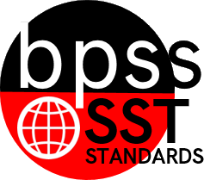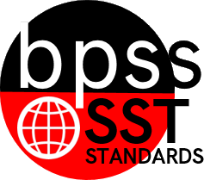8th Grade Social Studies (Archived)
 BPS District Social Studies Standards Book
BPS District Social Studies Standards Book
SST-08 "I can ... statements"
1st Grade Social Studies
2nd Grade Social Studies
4th Grade Social Studies
5th Grade Social Studies
7th Grade Social Studies
8th Grade Social Studies
| All categories |
PRIORITIZED BENCHMARKS |
|---|
SST-08.1.01
Student Learning Targets:Knowledge Targets
Reasoning Targets
Skills (Performance) Targets
Product Targets
Proficiency Scale
ResourcesWebsitesVocabulary
| ||||||||||||||||||||||||||||||||||||||||
SST-08.1.02
8th Grade US History Student Learning Targets:Knowledge Targets
Reasoning Targets
Skills Targets
8th Grade US History Proficiency Scale
8th Grade US History ResourcesWebsitesVocabulary
8th Grade ND Studies Learning Targets:Knowledge Targets
Reasoning Targets
Skills Targets
Product Targets
ND Studies Proficiency Scale
ND Studies ResourcesWebsitesVocabulary
| ||||||||||||||||||||||||||||||||||||||||||||||||||||||||||||||||||||||||||||
SST-08.2
Narrative for the Important Historical EventsIn the future this will contain narratives and other information about the Standard. Calculation Method for StandardsStandards are larger groups of related benchmarks. The Standard Grade is a calculation of all the related benchmarks. Click on the benchmark name below each Standard to access the learning targets and proficiency rubrics for each standard's related benchmarks. | |
SST-08.2.01
Student Learning Targets:Knowledge Targets
Reasoning Targets
Skills (Performance) Targets
Proficiency Scale
ResourcesWebsites
Vocabulary
| ||||||||||||||||||||||||||||||||||||||||||||
SST-08.2.04
Student Learning Targets:Knowledge Targets
Reasoning Targets
Skills (Performance) Targets
Product Targets
Proficiency Scale
ResourcesWebsites
Vocabulary
| ||||||||||||||||||||||||||||||||||||||||
SST-08.2.06
Student Learning Targets:Knowledge Targets
Reasoning Targets
Skills (Performance) Targets
Proficiency Scale
ResourcesWebsites
Vocabulary
| ||||||||||||||||||||||||||||||||||||||||
SST-08.2.07
Student Learning Targets:Knowledge Targets
Reasoning Targets
Skills (Performance) Targets
Proficiency Scale
ResourcesWebsites
Vocabulary | ||||||||||||||||||||||||||||||||||||||||
SST-08.2.11
Student Learning Targets:Knowledge Targets
Reasoning Targets
Conflict on the PlainsProficiency Scale
Homesteading Proficiency Scale
ResourcesWebsites
Vocabulary
Bonanza FarmsProficiency Scale
ResourcesWebsitesVocabulary
Statehood and DevelopmentProficiency Scale
ResourcesWebsitesVocabulary
| ||||||||||||||||||||||||||||||||||||||||||||||||||||||||||||||||||||||||||||||||||||||||||||||||||||||||||||||||||||||||||||||||||||||||||||||||||||
SST-08.3
Narrative for the Economic ConceptsIn the future this will contain narratives and other information about the Standard. Calculation Method for StandardsStandards are larger groups of related benchmarks. The Standard Grade is a calculation of all the related benchmarks. Click on the benchmark name below each Standard to access the learning targets and proficiency rubrics for each standard's related benchmarks. | |
SST-08.3.02
Student Learning Targets:Knowledge Targets
Reasoning Targets
Skills (Performance) Targets
Product Targets
Proficiency Scale
ResourcesWebsites Vocabulary | ||||||||||||||||||||||||||||||||||||||||||||
SST-08.3.04
Student Learning Targets:Knowledge Targets
Reasoning Targets
Skills (Performance) Targets
Proficiency Scale
ResourcesWebsitesVocabulary
| ||||||||||||||||||||||||||||||||||||||||
SST-08.4
Narrative for the Government and CitizenshipIn the future this will contain narratives and other information about the Standard. Calculation Method for StandardsStandards are larger groups of related benchmarks. The Standard Grade is a calculation of all the related benchmarks. Click on the benchmark name below each Standard to access the learning targets and proficiency rubrics for each standard's related benchmarks. | |
SST-08.4.01
Student Learning Targets:Knowledge Targets
Reasoning Targets
Skills (Performance) Targets
Proficiency Scale
ResourcesWebsites
Vocabulary
| ||||||||||||||||||||||||||||||||||||||||||||
SST-08.4.02
Student Learning Targets:Knowledge Targets
Reasoning Targets
Product Targets
Proficiency Scale
ResourcesWebsites
Vocabulary
| ||||||||||||||||||||||||||||||||||||||||||||
SST-08.4.03
Student Learning Targets:Knowledge Targets
Reasoning Targets
Proficiency Scale
ResourcesWebsites
Vocabulary
| ||||||||||||||||||||||||||||||||||||||||||||||||||||
SST-08.4.04
Student Learning Targets:Knowledge Targets
Reasoning Targets
Proficiency Scale
ResourcesWebsites
Vocabulary
| ||||||||||||||||||||||||||||||||||||||||||||
SST-08.4.05
Student Learning Targets:Knowledge Targets
Reasoning Targets
Proficiency Scale
ResourcesWebsites
Vocabulary
| ||||||||||||||||||||||||||||||||||||||||||||
SST-08.4.06
Student Learning Targets:Knowledge Targets
Reasoning Targets
Proficiency Scale
ResourcesWebsitesVocabulary
| ||||||||||||||||||||||||||||||||||||||||
SST-08.5
Narrative for the Concepts of GeographyIn the future this will contain narratives and other information about the Standard. Calculation Method for StandardsStandards are larger groups of related benchmarks. The Standard Grade is a calculation of all the related benchmarks. Click on the benchmark name below each Standard to access the learning targets and proficiency rubrics for each standard's related benchmarks. | |
SST-08.5.01
Student Learning Targets:Knowledge Targets
Reasoning Targets
Product Targets
Proficiency Scale
ResourcesWebsitesVocabulary
| ||||||||||||||||||||||||||||||||||||||||
SST-08.5.02
Student Learning Targets:Knowledge Targets
Reasoning Targets
Skills (Performance) Targets
Proficiency Scale
ResourcesWebsites Vocabulary | ||||||||||||||||||||||||||||||||||||||||
SST-08.6
Narrative for the Human Development and BehaviorIn the future this will contain narratives and other information about the Standard. Calculation Method for StandardsStandards are larger groups of related benchmarks. The Standard Grade is a calculation of all the related benchmarks. Click on the benchmark name below each Standard to access the learning targets and proficiency rubrics for each standard's related benchmarks. | |
STANDARD 1: SKILLS AND RESOURCES |
|---|
SST-08.1
Narrative for the Skills and ResourcesIn the future this will contain narratives and other information about the Standard. Calculation Method for StandardsStandards are larger groups of related benchmarks. The Standard Grade is a calculation of all the related benchmarks. Click on the benchmark name below each Standard to access the learning targets and proficiency rubrics for each standard's related benchmarks. | |
SST-08.1.01
Student Learning Targets:Knowledge Targets
Reasoning Targets
Skills (Performance) Targets
Product Targets
Proficiency Scale
ResourcesWebsitesVocabulary
| ||||||||||||||||||||||||||||||||||||||||
SST-08.1.02
8th Grade US History Student Learning Targets:Knowledge Targets
Reasoning Targets
Skills Targets
8th Grade US History Proficiency Scale
8th Grade US History ResourcesWebsitesVocabulary
8th Grade ND Studies Learning Targets:Knowledge Targets
Reasoning Targets
Skills Targets
Product Targets
ND Studies Proficiency Scale
ND Studies ResourcesWebsitesVocabulary
| ||||||||||||||||||||||||||||||||||||||||||||||||||||||||||||||||||||||||||||
STANDARD 2: HISTORY |
|---|
SST-08.2
Narrative for the Important Historical EventsIn the future this will contain narratives and other information about the Standard. Calculation Method for StandardsStandards are larger groups of related benchmarks. The Standard Grade is a calculation of all the related benchmarks. Click on the benchmark name below each Standard to access the learning targets and proficiency rubrics for each standard's related benchmarks. | |
SST-08.2.01
Student Learning Targets:Knowledge Targets
Reasoning Targets
Skills (Performance) Targets
Proficiency Scale
ResourcesWebsites
Vocabulary
| ||||||||||||||||||||||||||||||||||||||||||||
SST-08.2.02
| ||||||||||||
SST-08.2.03
Student Learning Targets:Knowledge Targets
Reasoning Targets
Skills (Performance) Targets
Product Targets
Proficiency Scale
ResourcesWebsites Vocabulary | ||||||||||||||||||||||||||||||||||||||||||||
SST-08.2.04
Student Learning Targets:Knowledge Targets
Reasoning Targets
Skills (Performance) Targets
Product Targets
Proficiency Scale
ResourcesWebsites
Vocabulary
| ||||||||||||||||||||||||||||||||||||||||
SST-08.2.05
Student Learning Targets:Knowledge Targets
Reasoning Targets
Skills (Performance) Targets
Product Targets
Proficiency Scale
ResourcesWebsites Vocabulary | ||||||||||||||||||||||||||||||||||||||||
SST-08.2.06
Student Learning Targets:Knowledge Targets
Reasoning Targets
Skills (Performance) Targets
Proficiency Scale
ResourcesWebsites
Vocabulary
| ||||||||||||||||||||||||||||||||||||||||
SST-08.2.07
Student Learning Targets:Knowledge Targets
Reasoning Targets
Skills (Performance) Targets
Proficiency Scale
ResourcesWebsites
Vocabulary | ||||||||||||||||||||||||||||||||||||||||
SST-08.2.08
Student Learning Targets:Knowledge Targets
Reasoning Targets
Skills (Performance) Targets
Product Targets
Proficiency Scale
ResourcesWebsites Vocabulary | ||||||||||||||||||||||||||||||||||||||||||||
SST-08.2.09
Student Learning Targets:Knowledge Targets
Reasoning Targets
Skills (Performance) Targets
Product Targets
Proficiency Scale
ResourcesWebsites Vocabulary | ||||||||||||||||||||||||||||||||||||||||||||
SST-08.2.10
Student Learning Targets:Knowledge Targets
Reasoning Targets
Skills (Performance) Targets
Product Targets
Proficiency Scale
ResourcesWebsites Vocabulary | ||||||||||||||||||||||||||||||||||||||||||||
SST-08.2.11
Student Learning Targets:Knowledge Targets
Reasoning Targets
Conflict on the PlainsProficiency Scale
Homesteading Proficiency Scale
ResourcesWebsites
Vocabulary
Bonanza FarmsProficiency Scale
ResourcesWebsitesVocabulary
Statehood and DevelopmentProficiency Scale
ResourcesWebsitesVocabulary
| ||||||||||||||||||||||||||||||||||||||||||||||||||||||||||||||||||||||||||||||||||||||||||||||||||||||||||||||||||||||||||||||||||||||||||||||||||||
STANDARD 3: ECONOMICS |
|---|
SST-08.3
Narrative for the Economic ConceptsIn the future this will contain narratives and other information about the Standard. Calculation Method for StandardsStandards are larger groups of related benchmarks. The Standard Grade is a calculation of all the related benchmarks. Click on the benchmark name below each Standard to access the learning targets and proficiency rubrics for each standard's related benchmarks. | |
SST-08.3.01
Student Learning Targets:Knowledge Targets
Reasoning Targets
Skills (Performance) Targets
Product Targets
Proficiency Scale
ResourcesWebsites Vocabulary | ||||||||||||||||||||||||||||||||||||||||||||
SST-08.3.02
Student Learning Targets:Knowledge Targets
Reasoning Targets
Skills (Performance) Targets
Product Targets
Proficiency Scale
ResourcesWebsites Vocabulary | ||||||||||||||||||||||||||||||||||||||||||||
SST-08.3.03
Student Learning Targets:Knowledge Targets
Reasoning Targets
Skills (Performance) Targets
Product Targets
Proficiency Scale
ResourcesWebsites Vocabulary | ||||||||||||||||||||||||||||||||||||||||||||
SST-08.3.04
Student Learning Targets:Knowledge Targets
Reasoning Targets
Skills (Performance) Targets
Proficiency Scale
ResourcesWebsitesVocabulary
| ||||||||||||||||||||||||||||||||||||||||
STANDARD 4: POLITICAL SYSTEMS |
|---|
SST-08.4
Narrative for the Government and CitizenshipIn the future this will contain narratives and other information about the Standard. Calculation Method for StandardsStandards are larger groups of related benchmarks. The Standard Grade is a calculation of all the related benchmarks. Click on the benchmark name below each Standard to access the learning targets and proficiency rubrics for each standard's related benchmarks. | |
SST-08.4.01
Student Learning Targets:Knowledge Targets
Reasoning Targets
Skills (Performance) Targets
Proficiency Scale
ResourcesWebsites
Vocabulary
| ||||||||||||||||||||||||||||||||||||||||||||
SST-08.4.02
Student Learning Targets:Knowledge Targets
Reasoning Targets
Product Targets
Proficiency Scale
ResourcesWebsites
Vocabulary
| ||||||||||||||||||||||||||||||||||||||||||||
SST-08.4.03
Student Learning Targets:Knowledge Targets
Reasoning Targets
Proficiency Scale
ResourcesWebsites
Vocabulary
| ||||||||||||||||||||||||||||||||||||||||||||||||||||
SST-08.4.04
Student Learning Targets:Knowledge Targets
Reasoning Targets
Proficiency Scale
ResourcesWebsites
Vocabulary
| ||||||||||||||||||||||||||||||||||||||||||||
SST-08.4.05
Student Learning Targets:Knowledge Targets
Reasoning Targets
Proficiency Scale
ResourcesWebsites
Vocabulary
| ||||||||||||||||||||||||||||||||||||||||||||
SST-08.4.06
Student Learning Targets:Knowledge Targets
Reasoning Targets
Proficiency Scale
ResourcesWebsitesVocabulary
| ||||||||||||||||||||||||||||||||||||||||
STANDARD 5: GEOGRAPHY |
|---|
SST-08.5
Narrative for the Concepts of GeographyIn the future this will contain narratives and other information about the Standard. Calculation Method for StandardsStandards are larger groups of related benchmarks. The Standard Grade is a calculation of all the related benchmarks. Click on the benchmark name below each Standard to access the learning targets and proficiency rubrics for each standard's related benchmarks. | |
SST-08.5.01
Student Learning Targets:Knowledge Targets
Reasoning Targets
Product Targets
Proficiency Scale
ResourcesWebsitesVocabulary
| ||||||||||||||||||||||||||||||||||||||||
SST-08.5.02
Student Learning Targets:Knowledge Targets
Reasoning Targets
Skills (Performance) Targets
Proficiency Scale
ResourcesWebsites Vocabulary | ||||||||||||||||||||||||||||||||||||||||
SST-08.5.03
Student Learning Targets:Knowledge Targets
Reasoning Targets
Skills (Performance) Targets
Product Targets
Proficiency Scale
ResourcesWebsites Vocabulary | ||||||||||||||||||||||||||||||||||||||||||||
STANDARD 6: HUMAN DEVELOPMENT |
|---|
SST-08.6
Narrative for the Human Development and BehaviorIn the future this will contain narratives and other information about the Standard. Calculation Method for StandardsStandards are larger groups of related benchmarks. The Standard Grade is a calculation of all the related benchmarks. Click on the benchmark name below each Standard to access the learning targets and proficiency rubrics for each standard's related benchmarks. | |
SST-08.6.01
Student Learning Targets:Knowledge Targets
Reasoning Targets
Skills (Performance) Targets
Product Targets
Proficiency Scale
ResourcesWebsites Vocabulary | ||||||||||||||||||||||||||||||||||||||||||||
SST-08.6.02
Student Learning Targets:Knowledge Targets
Reasoning Targets
Skills (Performance) Targets
Product Targets
ResourcesWebsites Vocabulary | ||||||||||||||||||||||||||||||||||||||||||||


 Standard 1:
Standard 1: